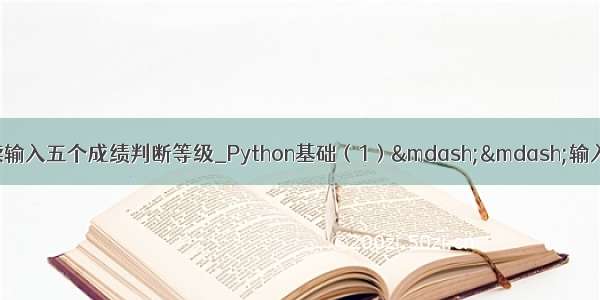
变量以及类型
变量:存储程序运行中的数据,变量有3个要素:变量名、变量类型、变量值。python属于弱类型语言,不需要声明变量类型。
[root@localhost python]# ipython3
In [1]: a=1 //变量名=变量值;在堆内存中的一个区域存了一个值为1,内存分为堆内存和栈内存,栈内存的是引用。指向堆内存中的值。
In [4]: b=88In [5]: c=a+b
In [7]: c
Out[7]: 89In [8]: a
Out[8]: 1In [9]: type(a)
Out[9]: intIn [10]: type(c)
Out[10]: intIn [11]: str="hello"In [12]: str
Out[12]: 'hello'In [13]: x,y=1,2In [14]: x
Out[14]: 1In [15]: y
Out[15]: 2In [16]:
In [16]: type(str)
Out[16]: str
变量类型
标识符:自定义的一些符号和名称,标识符是自己定义的,如变量名、函数名等。
规则:由字母、下划线和数字组成,且不能以数字开头;不能包含一些有特殊意义的符号,如#.&!()等;同时区分大小写。
大小写规则:
驼峰命名法:如小驼峰:userName / userLoginFlag 大驼峰:UserName;类的名字一般首字母大写。
下划线规则:user_name user_login_flag
保留字/关键字:在计算机中有特殊含义的单词。
In [1]: importkeyword
In [2]: keyword.kwlist
Out[2]:
['False','None','True','and','as','assert','break','class','continue','def','del','elif','else','except','finally','for','from','global','if','import','in','is','lambda','nonlocal','not','or','pass','raise','return','try','while','with','yield']
In [3]:
输出和输出格式
In [4]: print('hello','world','zyj','hello') //输出多个变量
hello world zyj hello
In [5]: print(111+222) //输出表达式
333In [6]: exit
[root@localhost python]#vim3.py1 a=35
2 print("my age is:%d"%a ) //变量替换
[root@localhost python]# python3 3.py
my age is:35[root@localhost python]#vim3.py1 a=35
2 b=10
3 print("my age is:%d"%a+b)
[root@localhost python]# python33.py
Traceback (most recent calllast):
File"3.py", line 3, in print("my age is:%d"%a+b) //错误行
TypeError: must be str, not int //错误类型
[root@localhost python]#vim 3.py1 a=35
2 b=10
3 print("my age is:%d"%(a+b)) //表达式需要用括号括起来
[root@localhost python]# python3 3.py
my age is:45[root@localhost python]#vim3.py1 a=35
2 b=10
3 my_name="zyj"
4 print("my age is:%d,my name is:%s" %(a+b,my_name)) //如果需要多个变量替换也要加小括号,并且每个变量用逗号隔开,%d代表整数类型替换,%s代表所有的类型变量替换,可以只记住%s
[root@localhost python]# python3 3.py
my age is:45,my name is:zyj
[root@localhost python]# vim3.py1 a=35
2 b=10
3 my_name="zyj"
4 print("my age is:%d,my name is:%s" %(a+b,my_name))5 money=2
6 print("I have money:%04d" %money)//不够4位前面用0填充
7 w=3.1415926
8 print("w is:%.2f"%w) //输出的数字包含两位小数,如果没有用0填充
9 print("it's:%d%%"%a) //%表示占位符,%%第一个%表示转义符
[root@localhost python]# python3 3.py
my age is:45,my name is:zyj
I have money:0002
w is:3.14it's:35%
输入和运算符:注意python2和python3中的一些区别。
输入:用户从电脑输入一些字符,可以让用户输入。
[root@localhost python]# vim 02输入.py1 #encoding=UTF-8
2#raw_input()只在python2中有,将输入内容作为字符串。区别13 a=raw_input("请输入你的名字:") //
[root@localhost python]# python 02输入.py
请输入你的名字:zyj
[root@localhost python]#
[root@localhost python]# vim 02输入.py4#input函数在python2和python3中都有5#在python2中input函数输入的内容作为表达式,而不是字符串,在python3作为字符串。在python3中取消支持表达式,可以防止某些恶意脚本中包含大量的表达式,提升安全性。区别26 a=input("请输入姓名:")7print(a)
[root@localhost python]# python3 02输入.py
请输入姓名:ZYJ
ZYJ
[root@localhost python]# python 02输入.py
请输入姓名:11+11
22
[root@localhost python]# vim 02输入.py6 name=input("请输入姓名:")7print(name)8 age=input("请输入年龄:")9 print("你输入的姓名:%s,你输入的年龄:%s" %(name,age))
[root@localhost python]# python3 02输入.py
请输入姓名:zyj
zyj
请输入年龄:18[root@localhost python]# vim 02输入.py6 name=input("请输入姓名:")7print(name)8 age=input("请输入年龄:")9print(type(age))10 age=age+2 //年龄加2岁
11 print("你输入的姓名:%s,你输入的年龄:%s" %(name,age))Traceback (most recent calllast):
File"02输入.py", line 10, in age=age+2TypeError: must be str, not int //age为字符串,第10行只能字符串相加
[root@localhost python]# vim 02输入.py6 name=input("请输入姓名:")7print(name)8 age=input("请输入年龄:")9print(type(age))10 age=int(age)+2 //转换类型后进行相加
11 print("你输入的姓名:%s,你输入的年龄:%s" %(name,age))
[root@localhost python]# python3 02输入.py
请输入姓名:zyj
zyj
请输入年龄:18
你输入的姓名:zyj,输入的年龄:20
运算符:
赋值运算符=:把=右边的结果给左边的变量。注意区别与==,==为数学中的等于号;
+-*/%//** 加减乘除取余取整除幂
In [1]: 3**2Out[1]: 9In [2]: 3//2
Out[2]: 1In [3]: 3/2Out[3]: 1.5In [4]: 3%2Out[4]: 1
复合赋值运算符:前后先操作再赋值
+=-=*= /= %= **= //=
In [7]: a=3In [9]: b=2In [10]: b+=a //b=b+a
In [11]: b
Out[11]: 5
In [13]: a=6In [14]: a*=23-21+34-7 //a=6*(29)In [15]: a
Out[15]: 174
条件判断
if:
执行1elif:
执行2elif:
执行3else:
执行4
举例:
[root@localhost python]#vim 04.py
1 age=input("age:")2 age=int(age)3 sex=input("sex:")4 #and or not
5 if age >=18 and sex == "man" :
6 print('you can do it')
7 elif age <18 or sex == "woman" :
8 print("you can't do it")
9 elif not (sex == "man" or sex == "woman"):#sex != "woman" and sex != "man" //<>也是不等于
10 print("人妖")
11 else:
12 pass #以后填充代码,为了保证不出现语法错误,当由else:又没有写其他的时候会出现语法错误
[root@localhost python]#python3 04.py
age:19sex:man
you can do it
[root@localhost python]#python3 04.py
age:14sex:woman
you can't do it
[root@localhost python]#vim 04.py
[root@localhost python]#python3 04.py
age:13sex:dsfdsf
you can't do it
[root@localhost python]#python3 04.py
age:19sex:dfdsf
人妖
小技巧:age:dfsdfsdf^H^H^H^H^H^H^H 当键盘输入删除符时会当作字符,此时需要按ctrl+backspace键可以删除。
特殊的真和假
真:非0
假:0 “” None [] () {}
[root@localhost python]#vim 05.py
1 age=int(input('age:'))2 ifage:3 print("age不为0")4 else:5 print("age为0")6 name=""
7 ifname:8 print("name 不是空字符串")9 else:10 print("name 是空字符串")
[root@localhost python]#python3 05.py
age:0
age为0
name 是空字符串
练习:
1、根据BMI公式(体重除以身高的平方)计算输入人的BMI指数,低于18.5过轻,18.5-25正常,25-28过重,高于32严重肥胖,用if-elif输出打印出来
[root@localhost python]#vim 06.py
1 h=float(input("input your height:"))2 w=float(input("input your weight:"))3 print("your height is %.2f,weight is %.2f"%(h,w))4 BMI=w/(h**2)5 if BMI <18.5:6 print("you are too light")7 elif BMI >=18.5 and BMI <25:8 print("you are nomal")9
10 elif BMI >=25 and BMI <32:11 print("you are weight")12
13 else:14 print("you are too weight")15 print("your BMI is:%.2f"%BMI)
[root@localhost python]#python3 06.py
input your height:1.50input your weight:48your heightis 1.50,weight is 48.00you are nomal
your BMIis:21.33[root@localhost python]#
2、情节描述:输入公交卡余额,超过2元就可以上车,如果空位置数量大于0,就可以坐下;
[root@localhost python]#vim 07.py
1 b=float(input("please input your balance:"))2 s=int(input("please input the number of the empty seat:"))3 print("your balance is:%.2f,the empty seat is:%d"%(b,s))4 if b >= 2 and s >0:5 print("please get on and you have a seat")6 elif b >= 2 and s <= 0: //第一次忘记写:号,第二次调式的时候与预期不一致,忘记写=号,输入0时没有匹配到。边界值测试7 print("you can get on but there is no seat for you")8 else:9 print("sorry you can't get on,because your balance is too short")10 print("goodluck to you")
[root@localhost python]#python3 07.py
File "07.py", line 6
elif b >= 2 and s <0^SyntaxError: invalid syntax
[root@localhost python]#vim 07.py 6 //进去后光标在报错行#运行测试,查看结果
[root@localhost python]#python3 07.py
please input your balance:2 #边界值测试
please input the number of the empty seat:0 #边界值
your balance is:2.00,the empty seat is:0
you can get on but thereis no seat foryou
goodluck to you
[root@localhost python]#python3 07.py
please input your balance:1 #正常值测试
please input the number of the empty seat:3 #正常值
your balance is:1.00,the empty seat is:3sorry you can't get on,because your balance is too short
goodluck to you
[root@localhost python]#python3 07.py
please input your balance:0
please input the number of the empty seat:0
your balanceis:0.00,the empty seat is:0
sorry you can't get on,because your balance is too short
goodluck to you
[root@localhost python]#python3 07.py
please input your balance:10please input the number of the empty seat:10your balanceis:10.00,the empty seat is:10please get onandyou have a seat
goodluck to you
[root@localhost python]#python3 07.py
please input your balance:-1 #非法值测试
please input the number of the empty seat:-1#非法值测试
your balance is:-1.00,the empty seat is:-1sorry you can't get on,because your balance is too short
goodluck to you
[root@localhost python]#python3 07.py
please input your balance:1000000000000000000000000 #超大值测试
please input the number of the empty seat:1000000000000000000000000your balanceis:999999999999999983222784.00,the empty seat is:1000000000000000000000000please get onandyou have a seat
goodluck to you
[root@localhost python]#
使用if嵌套实现,更符合正常逻辑。
[root@localhost python]#python3 07.py
1 m = float(input("money:"))2 s = int(input("seat:"))3 if m >= 2:4 print("you can get on")5 if s >0:6 print("there is a seat for you")7 else:8 print("sorry there is no seat for you")9 else:10 print("sorry,you can't get on")
[root@localhost python]#python3 08.py #边界值测试
money:2seat:0
you can get on
sorry thereis no seat foryou
[root@localhost python]#python3 08.py #正常值测试
money:2seat:1you can get on
thereis a seat foryou
[root@localhost python]#python3 08.py #非法值测试
money:-1seat:-1sorry,you can't get on
[root@localhost python]#python3 08.py #较大的值测试
money:100000000000000seat:1000000000000000000000you can get on
thereis a seat for you
循环:在程序中做相同的事情,需要使用循环。
while循环
while条件:
条件满足时,做的事情1
条件满足时,做的事情2
条件满足时,做的事情3
.......
举例:
求1加到100的和:
[root@localhost python]#vim 09.py
1 i = 1
2 s =03 while i <= 100: #满足条件的才进入while循环
4 s +=i5 #i++ python不支持这种写法
6 i+=1 #如果i不变的时候,一直为1,则会一直循环,出现死循环。
7 print("从1加到100的和为:%d" %s)
[root@localhost python]#python3 09.py
从1加到100的和为:5050
求1-100之间偶数的和,包含1和100。
[root@localhost python]#vim 10.py
1 i=1
2 s=03 while i <= 100:4 even = i % 2
5 if even ==0 :6 s+=i7 else:8 pass
9 i+=1
10 print("1和100之间的偶数和为:%d" %s)
[root@localhost python]#python3 10.py
1和100之间的偶数和为:2550
打印下面的图形:
[root@localhost python]#vim 12.py
1 i=1
2 while i <= 5:3 print(i*"*")4 i+=1[root@localhost python]#python3 12.py
*
**
***
****
*****
1 i=1
2 while i <= 10:3 print(10*"*")4 i+=1[root@localhost python]#python3 12.py
**********
**********
**********
**********
**********
**********
**********
**********
**********
**********
while循环嵌套
while条件1:
条件1满足时,做的事情1
条件1满足时,做的事情2
条件1满足时,做的事情3
.......while条件2:
条件2满足时,做的事情1
条件2满足时,做的事情2
条件2满足时,做的事情3
......
举例:用星号打印矩形
版本1:按照逻辑初次编写
1 x=1 #x为矩形长
2 y=1 #y为矩形宽
3
4 while y <= 10 :#输出10行
5 while x <= 10 :#在一行中输出10个*
6 print("*")7 x += 1
8 y += 1
9 print("pass")
[root@localhost python]#python3 11.py
*
*
*
*
*
*
*
*
*
*
pass #输出结果不符合预期
版本2:解决输出一行时,进行了换行的问题。
1 x=1 #x为矩形长
2 y=1 #y为矩形宽
3
4 while y <= 10 :#输出10行
5 while x <= 10 :#在一行中输出10个*
6 print("*",end="")#print函数默认输出后就会换行,如果不换行,end=""
7 x += 1
8 y += 1
9 print("pass")
[root@localhost python]# python3 11.py
**********pass #输出不符合预期
版本3:解决只打印了一行星号的问题。
1 x=1 #x为矩形长
2 y=1 #y为矩形宽
3
4 while y <= 10 :#输出10行
5 x=1 #每行执行完成后,x为11,若不重新赋值,则第二次大循环的时候不会进到小循环里面,因此只会输出一行*,因此这里需要重新赋值。
6 while x <= 10 :#在一行中输出10个*
7 print("*",end="")#print函数默认输出后就会换行,如果不换行,end=""
8 x += 1
9 y += 1
10 print("pass")
[root@localhost python]#python3 11.py
****************************************************************************************************pass #还是不满足预期
版本4:解决多行星号没有换行的问题
1 x=1 #x为矩形长
2 y=1 #y为矩形宽
3
4 while y <= 10 :#输出10行
5 x=1 #每行执行完成后,x为11,若不重新赋值,则第二次大循环的时候不会进到小循环里面,因此只会输出一行*
6 while x <= 10 :#在一行中输出10个*
7 print("*",end="")#print函数默认输出后就会换行,如果不换行,end=""
8 x += 1
9 print("")#每行结束后输出一个换行,print函数默认会输出换行
10 y += 1
11 print("pass")
[root@localhost python]#python3 11.py
**********
**********
**********
**********
**********
**********
**********
**********
**********
**********
pass
说明:查看python中函数的帮助文档:
[root@localhost ~]#ipython3
In [1]:help(print) #查看print()函数的帮助文档。
Help on built-in function print inmodule builtins:print(...)print(value, ..., sep=' ', end='\n', file=sys.stdout, flush=False)#默认输出后由换行符。
Prints the values to a stream, orto sys.stdout by default.
Optional keyword arguments:
file: a file-like object (stream); defaults to the current sys.stdout.
sep: string inserted between values, default a space.
end: string appended after the last value, default a newline.
flush: whether to forcibly flush the stream.
(END)
练习2:打印九九乘法表
[root@localhost python]#vim 13.py
1 x = 1 #行数
2 while x <= 9 : #一共循环9次,才能打印9行,每行打印的列数和行号一样
3 y = 1 #代表列数
4 while y <=x:5 print("%d*%d=%d\t"%(y,x,y*x),end="")6 y+=1
7 print("")8 x+=1[root@localhost python]#python3 13.py
1*1=1
1*2=2 2*2=4
1*3=3 2*3=6 3*3=9
1*4=4 2*4=8 3*4=12 4*4=16
1*5=5 2*5=10 3*5=15 4*5=20 5*5=25
1*6=6 2*6=12 3*6=18 4*6=24 5*6=30 6*6=36
1*7=7 2*7=14 3*7=21 4*7=28 5*7=35 6*7=42 7*7=49
1*8=8 2*8=16 3*8=24 4*8=32 5*8=40 6*8=48 7*8=56 8*8=64
1*9=9 2*9=18 3*9=27 4*9=36 5*9=45 6*9=54 7*9=63 8*9=72 9*9=81
循环要点:
1、循环次数:while中循环次数由条件决定;如九九乘法表中循环9次;
2、循环体:在循环过程中做什么,如打印一行九九乘法表;
3、变量怎么变化:如变量增加或者递减
break和continue
在循环中,break语句可以提前退出循环;
1 age = int(input("please input your age:"))2 i = 1
3 whileTrue :4 if i ==age:5 print("your age is %d" %i)6 break #不知道要循环几次的时候,可以使用break防止死循环。
7 else:8 print("wrong")9 i += 1[root@localhost python]#python3 14.py
please input your age:3wrong
wrong
your ageis 3
在循环过程中,continue语句,可以跳过当前的这次循环,直接开始下一次循环。终止当前的循环,开启下次循环。
1 i =02 while i < 10:3 i += 1
4 if i % 2 ==0:5 print("%d is enev" %i) #i是偶数的时候打印6 continue
7 print("i is %d" %i) #i不是偶数的时候打印8 else:
9 print("else 表示不满足条件时调试的代码,这时i为%d" %i) #不满足条件的时候执行else,注意while和这里的else是一个整体,这种方式不常用。10 print("结束")
[root@localhost python]#python3 15.py
i is 1
2 isenev
iis 3
4 isenev
iis 5
6 isenev
iis 7
8 isenev
iis 9
10 isenevelse表示不满足条件时调试的代码,这时i为10
结束
练习:使用*打印倒等边三角形,并且行号由用户输入。
1 i = int(input("请输入行数:"))2
3 a =04 while a < i :#假设i=4,打印4行,
5 b = 0 #定义空格
6 while b < a :#打印当前行前面的空格,第一行不打印空格,第二行打印1个,后面增加一个;
7 print(" ",end="")8 b += 1
9 c = i-a10 while c > 0 : #打印星号,第一行打印4个*,后面的行减1
11 print("*",end=" ")#打印*不换行,后面跟一个空格
12 c -= 1
13 print("")14 a += 1
[root@localhost python]#python3 16.py
请输入行数:3
* * *
* *
*[root@localhost python]#python3 16.py
请输入行数:4
* * * *
* * *
* *
*[root@localhost python]#python3 16.py
请输入行数:5
* * * * *
* * * *
* * *
* *
*[root@localhost python]#
[root@localhost python]#python3 16.py
请输入行数:10
* * * * * * * * * *
* * * * * * * * *
* * * * * * * *
* * * * * * *
* * * * * *
* * * * *
* * * *
* * *
* *
*[root@localhost python]#
1 i = int(input("请输入行数:"))2 a = 1 #控制行数,打印i行,初始值根据规律选择0或者1都可以。
3 while a <=i :4 b = i - a #定义空格
5 while b >0 :6 print(" ",end="")7 b -= 1
8 c = 0 #定义星号
9 while c
12 a += 1
13 print("")
[root@localhost python]#python3 17.py
请输入行数:4
*
* *
* * *
* * * *
for循环
for 临时变量 in集合或字符串等:
循环满足条件时执行的代码else:
循环不满足条件时执行的代码
举例1:
1 for i in "abcdefg":2 print(i)3 else:4 print("没有内容")
[root@localhost python]#python3 19.py
a
b
c
d
e
f
g
没有内容
[root@localhost python]#
举例2:
7 for i in range(1,10):8 print(i)9 else:10 print("没有内容")
[root@localhost python]#python3 19.py
1
2
3
4
5
6
7
8
9没有内容
[root@localhost python]#
















